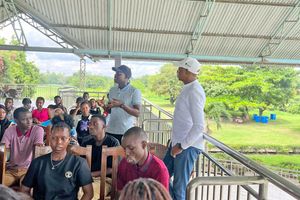Prime
How the revolution led to closure of NASA's tracking station in Zanzibar

The rusting remains of a former American satellite tracking station, pictured in 2004, located about 15 kilometres east of Stone Town near the village of Tunguu. PHOTO | COURTESY
What you need to know:
- The revolution that overthrew the Sultan and British-backed establishment empowered leaders who had long demanded the removal of the Mercury base
Zanzibar. Beneath the rusting sheet-metal structures in Tunguu and the now-farmed fields of Chwaka lies a forgotten but charged chapter in global space history—one that ended not with technological failure, but with political revolution.
By April 1964, just three years after it became operational, the Zanzibar node of NASA’s Project Mercury — once hailed as a vital “lifeline” in America’s space race — was shut down and dismantled at the insistence of the newly established revolutionary government led by President Abeid Amani Karume.

The Tunguu tracking station as seen in a photograph taken in 1961. PHOTO | COURTESY
According to The New York Times, in its April 8, 1964 article titled US Will Remove Zanzibar Station; It Accedes to Request on NASA Facility, the US agreed to close the site following a formal request from Zanzibar’s post-revolution leadership.
The paper reported; “The United States has agreed to remove a tracking station used in the Mercury space project from the East African island of Zanzibar… The action was taken after a formal request from the new revolutionary government.”
The swift action was not unexpected.
The Mercury station had long been a source of tension on the island, even before the first antenna had been raised.
As researcher Lisa Parks explains; “Throughout all phases of the Mercury station’s development, some Zanzibaris were ardently opposed and wanted it removed. Their political desire was gratified after Zanzibar’s revolution.”
A site built against the will of the people
The Mercury station, developed jointly by NASA and the British colonial authorities, had never truly been welcomed by the local population.
While officially pitched as a scientific facility supporting manned space flight, suspicions ran deep among Zanzibaris that the station was a disguised American military installation — a new colonial outpost in the global Cold War arena.
Prof Parks’ research shows that by June 1960, thousands of Zanzibaris had taken to the streets to protest what they called “rocketizing Zanzibar.”

Graffiti opposing the construction of the satellite tracking station in Zanzibar. PHOTO | COURTESY
ZNP leader Ali Muhsin called the station a “danger to the whole of Africa”, while anti-station posters and political cartoons and grafitti flooded local neighbourhoods.
Despite the protests and the sabotage of communication cables believed to be connected to the Mercury project, construction continued.

A newspaper clipping showing demonstrations opposing the NASA satellite tracking station in Zanzibar. PHOTO | COURTESY
As Prof Parks notes; “This node of the worldwide tracking network could only emerge because of a strategic, neocolonial partnership between the US and Britain... all in spite of vociferous Zanzibari political opposition to hosting it.”
The opposition, however, never waned.
In 1961, just months after the station helped track Alan Shepard’s flight into space, the ZNP’s newspaper ZANEWS published an article titled Against Rocketizing Zanzibar.
Its message was unequivocal: Zanzibar must not become a geopolitical pawn or military target.
By 1964, the geopolitical tides had turned.
The revolution that overthrew the Sultan and British-backed establishment empowered leaders who had long demanded the removal of the Mercury base.
Prof Parks writes: “One of the first things the new President, Abeid Amani Karume, did after seizing power on January 12, 1964, was to demand Project Mercury staff leave the island. He also ordered the station be shut down by the end of April 1964.”
The aftermath and lessons
Despite the facility’s short operational life, its removal had broader implications.
It exposed the fragile scaffolding of Cold War collaborations and raised difficult questions about the ethics of global scientific infrastructure—especially when built on contested land.
Today, almost nothing remains of the Mercury station in Zanzibar but ruins and memories.
When Parks visited the site in 2018, she found “concrete foundations, fence posts, a water well, pump houses, and a still-standing sheet metal structure.”
Locals farming the land admit having no knowledge of the site’s role in the space race.
It had been erased from collective memory—perhaps deliberately.
Yet Parks argues that the station remains significant, not just as a technical node, but as a “contrapuntal node” — one defined by contestation and the complex intersections of global power, local resistance, and technological ambition.
“The Mercury station in Zanzibar prompts consideration of what it means to build and operationalise a network node that was built against peoples’ will,” she writes.




